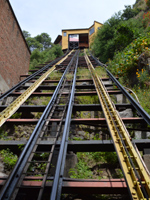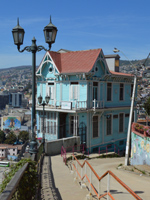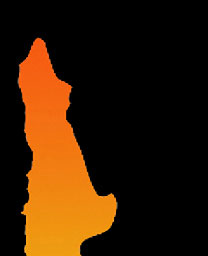

|
Journey to ValparaísoToday was a big day with a lot to do and a lot of complicated challenges. I checked out of my apartment in Santiago, rented a car, and drove to Valparaíso, about 120 kilometers away. It was the first time I've driven in South America and the first time I've gotten to see some of the open Chilean countryside. From the vast central valley where Santiago is located, I drove through the Cordillera Costanera, the coastal range of mountains that runs parallel to the Andes down much of the western edge of Chile. Vineyards were scattered across the green valley, while parched brown hills and mountains above revealed the sequía, the drought that Chile has been enduring for almost a decade. The open country gave way abruptly to urban turmoil as I drove into the heart of Valparaíso. This baudy old port city is only a two-hour drive from Santiago, but it is a world apart. While Santiago is gleaming and modern, Valparaíso is crumbling and chaotic. It rises up on steep hills above the harbor and the port, a jumble of colorfully painted houses that seem to defy gravity and geography as they hang from the precipitous hills. The narrow streets wind up the hills, forming a dense maze that confounds the sense of direction with every turn. The city really reminds me of San Francisco. It feels good to be back on the coast of the beautiful Pacific Ocean, with the salty air, the smell of fish, the cries of seagulls, the sense of freedom of the west coast. Valparaíso has been known by a number of nicknames over the years. Sailors going around Cape Horn referred to it as "Little San Francisco" and "The Jewel of the Pacific." More recently a national law was passed declaring it to be "Chile's Cultural Capital." UNESCO has designated the historic center of the city as a World Heritage Site, citing it as an "extraordinary example of industrial-age heritage associated with the international sea trade of the late 19th and early 20th centuries." Pablo Neruda described Valparaíso as "secretive, sinuous, winding." He extolled the many hills of Valparaíso and their legendary names: But these hills have profound names. Traveling through these names is a voyage that never ends, because the voyage through Valparaíso ends neither on earth nor in the word. Merry Hill, Butterfly Hill, Polanco's Hill, Hospital, Little Table, Corner, Sea Lion, Hauling Tackle, Potters', Chaparro's, Fern, Litre, Windmill, Almond Grove, Pequenes, Chercanes, Acevedo's, Straw, Prison, Vixens', Doña Elvira's, St. Stephen's, Astorga, Emerald, Almond Tree, Rodriguez's, Artillery, Milkmen's, Immaculate Conception, Cemetery, Thistle, Leaf y Tree, English Hospital, Palm Tree,
Queen Victoria's, Caravallo's, St. John of God, Pocuro's, Cove,
Goat, Biscayne, Don Elias's, Cape, Sugar Cane, Lookout, Parrasia,
Quince, Ox, Flower.
I rented a small cabaña on Cerro Florida, just down the hill from La Sebastiana, another one of Pablo Neruda's homes. The cabaña is rustic and simple, with an upstairs loft that has a beautiful balcony overlooking the city and the harbor. From here I can see the way human design and architecture have melded with the natural contours of the land. The hills are broken and separated by canyons, known as quebradas, and the houses are built right up to the edge of the quebradas. The construction here is very makeshift; everything seems to be cobbled together with salvaged lumber and corrugated metal. After getting settled into my cabaña, I walked down the hill to the "Plan" to begin my explorations of Valparaíso. The Plan is a narrow strip of flat land along the waterfront, an area of plazas and bustling commercial boulevards. The streets are crowded with people, the traffic is frantic, and sensory overload is overwhelming. A ship is leaving the harbor, sounding a loud call that resonates across the city. Church bells ring out from the hilltops while gulls cry out as they soar across the sky. From every corner of the city, the barking of dogs rises up in a cacophony of anguished tones. This is the Valparaíso symphony which performs around the clock. Valparaíso has quite a few similarities to San Francisco, as well as a number of cultural connections. Both cities are built on a series of more than 40 hills, both have a unique method of public transportation to traverse those hills, and both are rowdy port cities with a rich and colorful history. During the California Gold Rush, Valparaíso was a major stop for ships coming around Cape Horn. Chile exported vast quantities of wheat to feed the miners in California, and also exported a lot of her people, who went to the gold fields to seek their fortune. A neighborhood developed at the base of Telegraph Hill in San Francisco known as Little Chile, most of whose residents came from Valparaíso. And like San Francisco, Valparaíso was destroyed by a massive earthquake in 1906, just four months after the one in San Francisco. Uncanny that our two cities would both register the movement of the earth's crust in the same year.
The best way to get up and down the hills of Valparaíso is on the ascensores. These rickety contraptions, some of which date back to the late 1800s, provide residents with a quick, easy, and economical way to overcome the steep slopes. I spent the rest of the afternoon wandering through the hills of Valparaíso, riding the ascensores, and trying to keep my sense of direction.
|
||||||||||
|
|||||||||||
 |
|||||||||||
|
© 2015 Michael Hanrahan
|
|||||||||||


